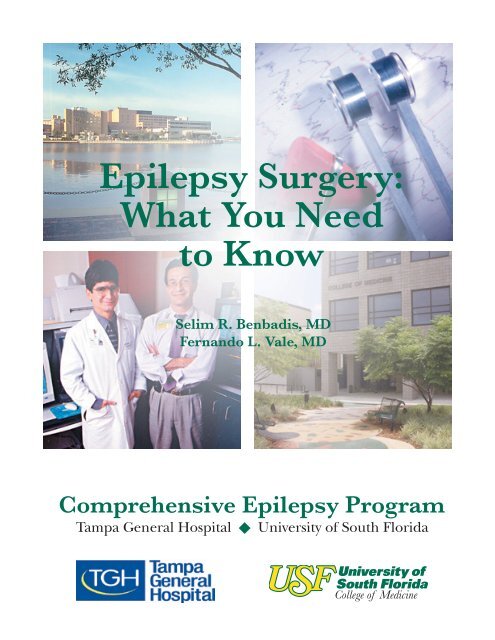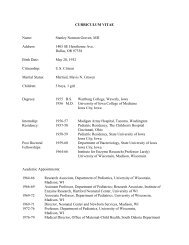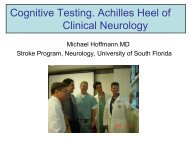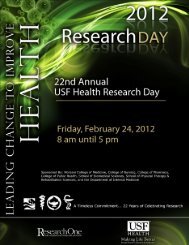Epilepsy Surgery - USF Health - University of South Florida
Epilepsy Surgery - USF Health - University of South Florida
Epilepsy Surgery - USF Health - University of South Florida
Create successful ePaper yourself
Turn your PDF publications into a flip-book with our unique Google optimized e-Paper software.
<strong>Epilepsy</strong> <strong>Surgery</strong>:<br />
What You Need<br />
to Know<br />
Selim R. Benbadis, MD<br />
Fernando L. Vale, MD<br />
Comprehensive <strong>Epilepsy</strong> Program<br />
Tampa General Hospital <strong>University</strong> <strong>of</strong> <strong>South</strong> <strong>Florida</strong>
Table <strong>of</strong> Contents<br />
* Introduction..............................................................................3<br />
* The evaluation for <strong>Epilepsy</strong> <strong>Surgery</strong>: When & How? .......3<br />
* What tests can you expect? ...................................................4<br />
Prolonged EEG-video monitoring ....................................4<br />
Imaging .................................................................................4<br />
Neuropsychological testing ...............................................5<br />
Wada test...............................................................................5<br />
Invasive EEG (phase II) evaluation ..................................5<br />
* Putting it all together ..............................................................6<br />
* Types <strong>of</strong> surgery.......................................................................6<br />
* Results and outcome ...............................................................7<br />
* Conclusions ..............................................................................7<br />
* Additional reading ..................................................................8<br />
Comprehensive <strong>Epilepsy</strong> Program<br />
Selim R. Benbadis, MD<br />
Associate Pr<strong>of</strong>essor<br />
Departments <strong>of</strong> Neurology & Neurological <strong>Surgery</strong><br />
Director, Comprehensive <strong>Epilepsy</strong> Program and Clinical Neurophysiology Laboratory<br />
<strong>University</strong> <strong>of</strong> <strong>South</strong> <strong>Florida</strong> & Tampa General Hospital<br />
Fernando L. Vale, MD<br />
Assistant Pr<strong>of</strong>essor<br />
Department <strong>of</strong> Neurological <strong>Surgery</strong><br />
Surgical Director, Comprehensive <strong>Epilepsy</strong> Program<br />
<strong>University</strong> <strong>of</strong> <strong>South</strong> <strong>Florida</strong> & Tampa General Hospital<br />
Phone: (813) 259-0605<br />
Website: http://epilepsy.usf.edu<br />
2
<strong>Epilepsy</strong> <strong>Surgery</strong>: What You Need to Know<br />
INTRODUCTION<br />
• Overall, medications works for about 70% <strong>of</strong> patients with epilepsy.<br />
• When they do not work, surgery is a well-accepted option for<br />
some types <strong>of</strong> epilepsy.<br />
• Of the 30% <strong>of</strong> patients whose seizures cannot be controlled<br />
with drugs, approximately half (more than 100,000 people in<br />
the U.S.) may be candidates for epilepsy surgery. Yet only about<br />
3,000 epilepsy surgeries are performed annually in the U.S,<br />
indicating a great need for more information about surgery <strong>of</strong><br />
epilepsy.<br />
This brief handout describes the essential facts you need to know<br />
about epilepsy surgery, and the testing that is usually involved. Keep<br />
in mind that you may not need all the tests described below.<br />
THE EVALUATION<br />
FOR EPILEPSY<br />
SURGERY:<br />
WHEN & HOW<br />
• <strong>Surgery</strong> is generally considered when medications fail to control<br />
the seizures.<br />
• How many medications should be tried before looking into<br />
surgery? The answer to this question has recently become clear:<br />
it is now known that if one fails 2 medications, then the chance<br />
<strong>of</strong> future success with any medications are less then 20%. If 3 or<br />
more medications have failed, then the chances <strong>of</strong> future success<br />
with any medications are less then 10%.<br />
• Thus, if 3 medications have been tried without success, it is reasonable<br />
(and advisable) to look into the possibility <strong>of</strong> surgery.<br />
• Unfortunately, neurologists do not always inform their patients<br />
that surgery is an option. Thus, many patients who could benefit<br />
from surgery are unaware <strong>of</strong> that possibility for many years.<br />
In fact, patients have sometimes been given wrong (and scary)<br />
information about the risks and benefits <strong>of</strong> epilepsy surgery.<br />
• When surgery is considered, a complex evaluation is performed<br />
to make sure that the operation will 1) improve the seizures,<br />
and 2) not cause damage to essential functions (for example<br />
movements, speech, memory).<br />
3
<strong>Epilepsy</strong> <strong>Surgery</strong>: What You Need to Know<br />
• Like other complex operations such as organ transplants, epilepsy<br />
surgery involves a whole team <strong>of</strong> different specialists. It is directed<br />
by a neurologist specializing in epilepsy (an “epileptologist”), with<br />
the input from other specialists including neuroradiologist, neuropsychologist,<br />
and <strong>of</strong> course neurosurgeon.<br />
WHAT TESTS<br />
CAN YOU<br />
EXPECT?<br />
Prolonged EEG-video monitoring<br />
• This is the first phase for all potential surgery candidates (in fact<br />
it should be performed in all patients whose seizures are uncontrolled<br />
despite medications).<br />
• With electrodes attached to the scalp, EEG (brain waves) and video<br />
are used to monitor the brain’s activity and record seizures.<br />
• This is usually done continuously (24 hours a day), and may last<br />
from a few hours to several days (in the hospital), depending on<br />
the time needed to record seizures.<br />
• It is <strong>of</strong>ten necessary to decrease or stop medications in order to<br />
obtain seizures within a reasonable time.<br />
• EEG-video monitoring achieves the following:<br />
o It confirms the diagnosis <strong>of</strong> epilepsy (it is the only way to make<br />
a positively certain diagnosis <strong>of</strong> epileptic seizures).<br />
o It distinguishes between partial (or focal) epilepsy, where seizures<br />
are localized at onset, and generalized epilepsies, where<br />
seizures arise from the whole brain.<br />
o If seizures are localized, it usually allows to pinpoint the zone <strong>of</strong><br />
seizure onset, which is very important for surgery.<br />
Imaging<br />
• MRI is the most accurate imaging technique, and is always necessary.<br />
Most patients with epilepsy have had normal MRIs, but subtle<br />
abnormalities are <strong>of</strong>ten found when MRI is performed specifically<br />
for epilepsy surgery (for example “mesial temporal sclerosis”). This<br />
is why we may repeat an MRI even though you have had some in<br />
the past.<br />
4
<strong>Epilepsy</strong> <strong>Surgery</strong>: What You Need to Know<br />
(What tests can you<br />
expect continued…)<br />
• SPECT (single photon emission tomography) is a nuclear scan<br />
performed during EEG-video monitoring (in the hospital). A tracer<br />
is injected IV at the beginning <strong>of</strong> a seizure, and a “snapshot” <strong>of</strong> the<br />
brain is taken.<br />
• PET (positron emission tomography) is very similar to SPECT, but<br />
is not taken during a seizure, so it is performed as an outpatient.<br />
Neuropsychological testing<br />
• This extensive battery <strong>of</strong> tests is performed (outpatient) to help<br />
analyze function <strong>of</strong> specific brain regions.<br />
• It includes IQ and memory tests.<br />
• It can be useful to confirm localization <strong>of</strong> seizure onset, and to<br />
predict (and prevent) possible neuropsychological side effects <strong>of</strong><br />
surgery.<br />
Wada test<br />
• This procedure is also called the intracarotid amobarbital (amytal)<br />
test.<br />
• It is performed during an angiogram, a standard neuroradiology<br />
procedure where a catheter is placed through the groin and dye is<br />
injected into the arteries that go to the brain (carotids).<br />
• One hemisphere at a time is put to sleep with medication for several<br />
minutes. Language and memory are then tested (by the neurologist<br />
or neuropsychologist or both). The procedure is then repeated<br />
for the other side.<br />
• It is used to localize areas <strong>of</strong> the brain that control language and<br />
memory function.<br />
Invasive EEG ("phase II") evaluation<br />
• This is only used when the above tests fails to pinpoint the location<br />
<strong>of</strong> seizure onset with enough confidence.<br />
• Only about 10% <strong>of</strong> surgery candidates require this phase.<br />
• It involves placing electrodes inside the skull (directly in contact to<br />
the brain) over a specific region <strong>of</strong> the brain.<br />
5
<strong>Epilepsy</strong> <strong>Surgery</strong>: What You Need to Know<br />
(What tests can you<br />
expect continued…)<br />
• Various techniques are available (depth, epidural, subdural electrodes).<br />
Some <strong>of</strong> these “invasive” electrodes also allow determining<br />
with precision the function <strong>of</strong> each area <strong>of</strong> cortex, so that critical<br />
area can be avoided during surgery, thus preventing complications<br />
on motor, sensory or language functions.<br />
PUTTING IT ALL<br />
TOGETHER<br />
• Once all the information is obtained, the entire epilepsy program<br />
team convenes to review each case in detail.<br />
• The team meets each week, and includes several neurologists/<br />
epileptologists, neurosurgeon, neuroradiologist, neuropsychologist,<br />
nurse coordinator, and EEG technologists.<br />
• All the results are reviewed, including history, exam, past history,<br />
EEG, videos, imaging, neuropsychological tests and Wada test. This<br />
is when the entire situation is discussed, and a plan is obtained with<br />
general agreement.<br />
TYPES OF<br />
SURGERY<br />
• <strong>Surgery</strong> is most commonly performed to treat partial (localized)<br />
epilepsy, since only one limited area <strong>of</strong> the brain is involved.<br />
• The most common operation is the resection (removal) <strong>of</strong> a specific<br />
area <strong>of</strong> cortex.<br />
o By far the most common operation is an anterior temporal lobe<br />
resection (temporal lobectomy). This represents about 80-90%<br />
<strong>of</strong> all surgeries for epilepsy.<br />
o Other areas can also be removed, most commonly parts <strong>of</strong> the<br />
frontal lobe.<br />
• When seizures are severe and arise from an extensive area <strong>of</strong> one<br />
hemisphere, one approach is to remove a large part <strong>of</strong> one side <strong>of</strong><br />
the brain (hemispherectomy).<br />
• Another approach is to cut the nerve fibers connecting the two<br />
sides <strong>of</strong> the brain (corpus callosotomy). This is done to help seizures<br />
for patients who have intractable generalized seizures that<br />
result in frequent falls and injuries.<br />
6
<strong>Epilepsy</strong> <strong>Surgery</strong>: What You Need to Know<br />
RESULTS &<br />
OUTCOMES<br />
• Overall about 70% <strong>of</strong> patients who have epilepsy surgery become<br />
seizure free.<br />
• However, in some circumstances, the chances <strong>of</strong> becoming seizure free are<br />
higher (>90%), and this can usually be predicted based on the results<br />
<strong>of</strong> the tests. For example, in cases where the results <strong>of</strong> EEGvideo<br />
monitoring and MRI are in agreement, over 90% <strong>of</strong> patients<br />
become seizure-free with a temporal lobectomy.<br />
• Many patients are completely free <strong>of</strong> seizures, while others may find<br />
their seizures reduced by varying degrees.<br />
• Some patients get <strong>of</strong>f medications, while others may have to continue<br />
to take medication.<br />
• It is rare that surgery is not helpful at all because we do not recommend<br />
it if the chances <strong>of</strong> success are low.<br />
• Complications are extremely rare, and the postoperative course is<br />
usually simple. After surgery, patients typically go home within 2-3<br />
days.<br />
• Please see our web site at http://hsc.usf.edu/~sbenbadi/<br />
EpilPGM.html, where the “epilepsy surgery book” is continuously<br />
updated with descriptions and patient testimonies.<br />
CONCLUSIONS<br />
• Remember that there is a lot <strong>of</strong> wrong information going around<br />
on epilepsy surgery.<br />
• Not all physicians (including neurologists) are up-to-date on the<br />
progress made in this field.<br />
• <strong>Epilepsy</strong> surgery is “standard <strong>of</strong> care” and is performed at all major<br />
(usually university-affiliated) medical centers.<br />
• There is plenty <strong>of</strong> literature, books and information available, if you<br />
need more detailed information.<br />
7
ADDITIONAL READING<br />
• Benbadis SR, Chelune GJ, Stanford L, Vale F. Outcome and complications <strong>of</strong> epilepsy surgery.<br />
In: Wyllie E (ed). The treatment <strong>of</strong> epilepsy: Principles and practice. 3rd edition. Philadelphia:<br />
Lippincott, Williams & Wilkins, 2001, pp. 1197-1211.<br />
• Benbadis SR. Evaluation for surgical treatment <strong>of</strong> partial epilepsy: an overview. Wisconsin<br />
Medical Journal 1995;94:500-504.<br />
• Benbadis SR. What can EEG-video monitoring do for you and your patients? Journal <strong>of</strong> the<br />
<strong>Florida</strong> Medical Association 1997;84:320-322.<br />
• Benbadis SR. <strong>Epilepsy</strong> explained. <strong>Health</strong>line 1997;16(5):8-9.<br />
• Benbadis SR. The management <strong>of</strong> epilepsy. <strong>Health</strong>line 1997;16(6):8-9.<br />
• Benbadis SR, Wyllie E. Evaluation <strong>of</strong> intractable seizures in children. In: Albright AL, Pollack<br />
IF, Adelson PD, (ed). Principle and practice <strong>of</strong> pediatric Neurosurgery. New York: Thieme,<br />
pp.1095-1109, 1999.<br />
• Benbadis SR. Invasive EEG in humans. In: Lüders HO, Noachtar S (eds). Epileptic seizures:<br />
pathophysiology and clinical semiology. New York: Churchill Livingstone, 2000, pp. 49-53.<br />
• Benbadis SR, Tatum WO IV. Advances in the treatment <strong>of</strong> epilepsy. American Family Physician<br />
2001;64:91-98.<br />
• Benbadis SR, Tatum WO IV, Vale FL. When drugs don’t work: An algorithmic approach to<br />
medically intractable epilepsy. Neurology 2000;55:1780-1784.<br />
• Lüders HO, Comair Y. <strong>Epilepsy</strong> surgery. Second Edition. Philadelphia: Lippincott, Williams &<br />
Wilkins, 2001.<br />
• Tatum WO IV, Benbadis SR, Vale FL. The neurosurgical treatment <strong>of</strong> epilepsy. Arch Fam Med<br />
2000;9:1142-7.<br />
• Wyllie E (ed). The treatment <strong>of</strong> epilepsy: Principles and practice. 3rd edition. Philadelphia:<br />
Lippincott, Williams & Wilkins, 2001.<br />
8
















